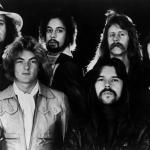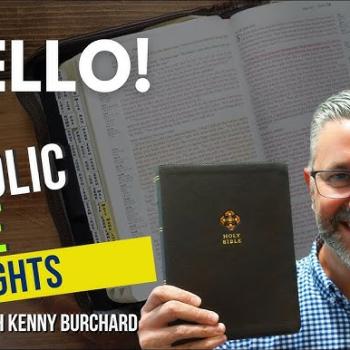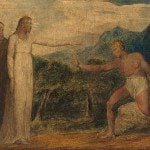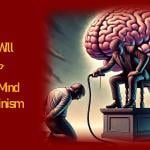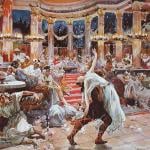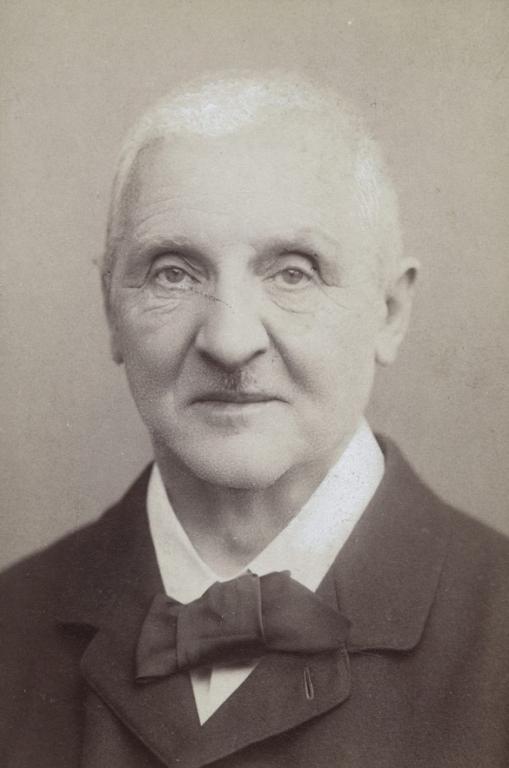
*
This is intended as an overview of several interesting tidbits (some of which I discovered last night) concerning Austrian composer Anton Bruckner (1824-1896). I am an unashamed, enthusiastic admirer of 19th-century German-Austrian romantic orchestral music (Wagner, Beethoven, and Mahler being my musical “trinity”). I played trombone in the orchestra and band (1973-1976) at Cass Technical High School in Detroit: a public school that has been nationally renowned for its musical program.
Bruckner can plausibly be regarded as the last of the great German-Austrian-Viennese symphonists and composers of the Romantic Period Proper (basically the 19th century). Brahms was his contemporary, but the two followed very different paths, with Brahms (more musically conservative, though even that may be an unfair simplification in some ways) hearkening back to Schubert and Schumann, whereas Bruckner was profoundly influenced by Wagner. Both saw themselves as continuing in the tradition of Beethoven (as did Wagner himself). This musical school (in a broad, inclusive sense) arguably came to an end with the “post-Romantics” Mahler (died 1911) and The Alpine Symphony of Richard Strauss (1915).
Was one school the true development of the universally revered Beethoven and the other a corruption? This was a matter of intense controversy in Bruckner’s day, but not so much anymore. We can appreciate each for its own qualities, with the benefit of hindsight. I believe that both general styles are legitimate musical developments of Beethoven and romantic classical music. Why does one have to choose? Live and let live.
I always thought that entire musical civil war was foolish and silly. The real revolution in music was to come with Debussy and Stravinsky, with their fluctuating tonalities and meters, and far more so, the American Charles Ives, with his outright dissonance and polyrhythmic and polytonal scores. Then came Schoenberg‘s 12-tone atonality, but even he started out as a fairly traditional romantic composer (e.g., his Pelleas und Melisande, 1907), and (ironically) considered himself in line with the tradition of Schubert, and Brahms. Compared to their “radical” scores, Bruckner looks like Mozart or even Haydn.
For those unacquainted with Bruckner, I recommend listening to his symphonies 4, 7, and 9 (in that order), followed by (if you want more) symphonies 8, 6, and 5. Two of my favorite recordings for awesome sound (especially the brass, which is always what I listen for) and tremendous performances are Bruno Walter conducting the Columbia Symphony Orchestra (largely the Los Angeles Philharmonic, and sounding for all the world like the peerless Vienna Philharmonic) in symphonies no. 4 and no. 9.
Other classics highly praised by critics are Herbert von Karajan conducting no. 7 (Berlin Philharmonic / Vienna Philharmonic), no. 8, and no. 9 (both Berlin Philharmonic), and Otto Klemperer’s no. 6 (Philharmonia Orchestra of London); also Daniel Barenboim and the Berlin Philharmonic for symphony no. 5. For complete sets, Bernard Haitink’s cycle with Amsterdam’s Concertgebouw Orchestra and Eugen Jochum’s with Berlin and Bavaria are both held in high esteem by critics and collectors.
From that day [the Austrian premiere of his seventh symphony in March 1886] . . . Bruckner’s position in the hierarchy of nineteenth-century symphonists was assured . . . . [a] deserved place in the musical firmament. (Martin Bookspan, 101 Masterpieces of Music and Their Composers, Garden City, New York: Doubleday & Co. / Dolphin Books, revised edition, 1973, 116)
[B]e assured, that this squat, homely, diffident man ranks with the greatest composers of the Romantic era . . . [the Bruckner symphonies] contain much that is immediately appealing, including some of the most heroic brass writing in all of music . . . (Jim Svejda, The Record Shelf Guide to Classical CDs and Audiocassettes, Rocklin, California: Prima Publishing, revised 4th edition, 1995, 125)
Unquestionably, however, he should figure prominently in a history of Romantic music . . . all of his nine or more symphonies . . . represent in the clearest and most magnificent manner one side of the Romantic movement, that arising from the mystical conception of sound . . .
He was in conformity with the spirit of the age only in so far as his art is inconceivable without the precedent of Beethoven and especially of Schubert . . . Bruckner took over with complete unconcern the great four-movement form of Beethoven’s symphonies and of Schubert’s C-major Symphony [9th], and again filled in the outline with content that was entirely his own and purely musical. (Alfred Einstein, Music in the Romantic Era, New York: W.W. Norton & Co., 1947, 155)
Bruckner is the direct descendant of the Beethoven of the Ninth Symphony and the Schubert of 1828. (Rey M. Longyear, Nineteenth-Century Romanticism in Music, Englewood Cliffs, New Jersey: Prentice-Hall, second edition, 1973, 192)
[H]is use of almost free dissonance, disjunct melodic writing, and abrupt chromatic chord progressions places him in advance of many of his peers. (Preston Stedman, The Symphony, Englewood Cliffs, New Jersey: Prentice-Hall, 1979, 180)
Bruckner’s symphonies present an utterly personal world of expression, and one very different from Wagner’s, in spite of some superficial resemblances in thematic material. They are so original in form that any attempt to relate them to Beethoven’s is also fruitless and beside the point. Huge masses of material are presented in apparent isolation. The ‘voids’ are followed by unexpected developments, which seem to be reaching for a climax only to fall away into another void, or into some sudden build-up of a persistent motif. Continuity is not of the essence, but tonal tensions are, and the final effect of Bruckner’s structures is a new kind of, and wholly unique, symmetry. . . . the music now remains unassailable in its splendour and originality. (in Charles Osborne, editor, The Dictionary of Composers, New York: Taplinger Publishing Co., 1977, 76; article by Alan Blyth)
Is it so extraordinary that a peasant born and bred, a simple, God-fearing soul, should have written music of genius? It is. But the nineteenth century was one in which anything might happen, a century in which eminent men were eccentric and unique, and not an intensification of types as they now tend to be. Bruckner’s type is familiar, his eminence unique. . . . in the century par excellence of individualism, he achieved a major work — major and original by the century’s own standards — by simply applying himself, with no deliberate aim at originality, no conscious exploiting of his personality, to a job of work, the writing of symphonies to the glory of God, in the frame of mind of any honest craftsman. (Ralph Hill, editor, The Symphony, Baltimore: Penguin Books, 1949; chapter by Richard Capell, 211-212)
Bruckner is not Beethovenish in his view of music, or in his psychological make-up. He has neither Beethoven’s range of imagination nor his tremendous smithy. There is no anvil in Bruckner, no hammer, no white-heat. Bruckner’s music is sturdy, without protest or rebelliousness. It is sure of itself even if it stumbles, which frequently it does. . . .
Of course, the duration of a Bruckner symphony is connected with the character and extent of the material treated, and to the way the mind of the composer works. It was an original mind. The simplicity of Bruckner has been overdone; it was a simplicity of nature, not of musical imagination. The argument and syntax, the unfolding and folding of a Bruckner symphony asks for close and intent musical thinking; his logic is less formal than that of say Brahms . . . We are not able confidently to go through a Bruckner movement guided by the recognizable first-subject and second-subject finger-posts, each unmistakably marking the crossroads . . . Bruckner has deeps worth our while to plumb.
. . . To ears fresh to Bruckner, the abrupt silences may well imply that the structure is insecure, that Bruckner has lost the thread to his discourse. A silence in Bruckner is called in German an Atempause; a pause to take in breath. Bruckner himself said that when he wanted to say something especially significant it was necessary for him first of all to create a silence. An intake of breath! — inspiration literally. . . .
We can also overdo the organist influence in Bruckner’s technique. His orchestration is masterful, with a sure ear for instrumental character. His judgment of dynamics is seldom at fault. He opens the heart of wood-wind; his brass is majestic or stirringly triumphant in turn, never merely brilliant or spectacular. His writing for strings, especially lower strings, is beautifully nuanced and harmonized . . . the Bruckner orchestral tissue . . is absolutely masculine. (Neville Cardus, Composers Eleven, New York: George Braziller, Inc., 1959, 91-95, 100)
[Anti-Wagnerite critic and Brahms partisan Eduard] Hanslick, admitting quite frankly that he found himself unable to judge Bruckner’s music dispassionately, nevertheless proceeded to blast away at it as “unnatural,” “inflated,” “sickly,” and “decayed.” . . . Bruckner reserved final judgment on Hanslick until late in his career . . . “I guess Hanslick understands as little about Brahms as about Wagner, me, and others. And the Doctor Hanslick knows as much about counterpoint as a chimney sweep about astronomy.” (Robart Bagar & Louis Biancolli, The Concert Companion, New York: McGraw-Hill Book Co., 1947, 143-144)
. . . one of the most important composers of the last hundred years . . . (Charles O’Connell, The Victor Book of the Symphony, New York: Simon and Schuster, revised edition, 1941, 171)
[Bruckner said to a friend] “I think that if Beethoven were alive, and I should go to him with my Seventh symphony and say, ‘Here, Mr. Beethoven, this is not so bad, this Seventh, as certain gentlemen would make out,’ — I think he would take me by the hand and say, ‘My dear Bruckner, never mind, I had no better luck; and the same men who hold me against you even now do not understand my last quartets, although they act as if they understood them.’ Then I’d say, ‘Excuse me, Mr. van Beethoven, that I have gone beyond you in freedom of form, but I think a true artist should make his own forms and stick by them.'” (Olin Downes, Symphonic Masterpieces, New York: Tudor Publishing Co., 1939, 163)
Bruckner was no simpleton. The Fifth Symphony in particular is testament to a gloriously wrought dovetailing of intellect and imagination.
An extraordinary pedigree of conductors have taken up Bruckner’s cause over the past century. And, increasingly, they’ve brought us to realize how far ahead of his time Bruckner was—or rather, how radically far he was outside our normative concepts of time and sequencing in classical music, where patterns of tension and release give us a sense of events occurring in a linear flow. As the brilliant musicologist Deryck Cooke observed, Bruckner’s “music has no need to go anywhere, no need to find a point of arrival, because it is already there.”
Bruckner was, in fact, quite removed from the concepts of late romanticism that prevailed during his own time . . .
Bruckner’s symphonies exist wholly on their own terms, expressing an inner drama. Robert Simpson, a 20th-century composer who authored perhaps the most perceptive general study on Bruckner (The Essence of Bruckner), saw him as in fact anti-romantic. In other words, instead of being about the drama of expectation and fulfillment, or the nervous excitement of “some all-embracing emotional climax,” Bruckner’s music burns with a “calm fire.” (Cleveland Orchestra program notes for 10-7-06, Thomas May [online] )
[Gustav Mahler wrote about Bruckner] “I was always one of his greatest admirers.”
“[P]erhaps I can call myself his pupil with more justice than most other people, and I shall always do so with profound respect and gratitude.”
“I think of you with all my longstanding friendship and admiration, and one of my aims in life is to contribute to the victory of your superb and masterly art.” (Henry-Louis de La Grange, Mahler, Garden City, New York: Doubleday & Co., Vol. 1, 1973, 48-49)
[Bruckner told Richard Wagner] “Dr Liszt played through my Fifth Symphony, and ‘proclaimed’ (his own words!) my virtues to [Prince] Hohenlohe. My only consolation in Vienna!”
[Johann Strauss, Jr., the famous waltz composer (Blue Danube, etc.), writing to Bruckner after hearing his Seventh Symphony]: “Am much moved — it was the greatest impression of my life.” (Martin Bookspan, 101 Masterpieces of Music and Their Composers, Garden City, New York: Doubleday & Co. / Dolphin Books, revised edition, 1973, 114)
. . . bow in homage to this man . . . I confess that scarcely anything in the new symphonic music can weave itself about me with such wonderful magic as can a single theme or a few measures of Bruckner . . . (Robart Bagar & Louis Biancolli, The Concert Companion, New York: McGraw-Hill Book Co., 1947, 144)
[W]hen he was examined for his skill in counterpoint by a committee of three, the conductor Anton Herbeck — the same who discovered the score of Schubert’s “Unfinished” symphony — said, “It is he who should examine us”; and Bruckner lived to teach theory and composition and lecture on these and other subjects at the Vienna Conservatory of Music. (Olin Downes, Symphonic Masterpieces, New York: Tudor Publishing Co., 1939, 165)
I confess that for many years, despite my love for Bruckner’s tonal language and his wonderful melodies, despite my happiness in his inspirations, I felt somewhat confused by his apparent formlessness, his unrestrained, luxurious prodigality. This confusion disappeared as soon as I began performing him. Without difficulty I achieved that identification with his work which is the foundation of every authentic and apparently authentic interpretation. Now, since I have long felt deeply at home in his realm, since his form no longer seems strange to me, I believe that access to him is open to everyone who approaches him with the awe due a true creator. His super-dimensions, his surrender to every fresh inspiration and new, interesting turning, sometimes not drawn with compelling musical logic from what has gone before, nor united to what follows, his abrupt pauses and resumptions: all this may just as well indicate a defect in constructive power as an individual concept of symphony. Even though he may not follow a strictly planned path to his goal, he takes us over ways strewn with abundant riches, affording us views of constantly varying delight. (Bruno Walter, Chord and Dischord [online] )
[A] kind of Gothic architecture in music . . . In the melodic content, towering structure and emotional world of these symphonies I found the immense, devout and childlike soul of their creator . . . I cannot put into words the importance that Bruckner’s works have had for my life since then and cannot express the extent to which my admiration of the beauty and symphonic power of his music has continued to increase and become an ever richer source of edification for me. (Bruno Walter, “On the Moral Strengths of Music,” 1935)
*
[Bruckner’s symphonies’] finest moments tend to be private and internal: the deeply spiritual utterances of an essentially medieval spirit who was completely out of step with his time.
. . . Adagio from the Fifth, in which we become party to one of the most moving spiritual journeys ever undertaken by a nineteenth-century composer. (Jim Svejda, The Record Shelf Guide to Classical CDs and Audiocassettes, Rocklin, California: Prima Publishing, revised 4th edition, 1995, 125)
[T]his music will take [many listeners] as close to God as humanly possible . . . these are not the works of a naive nor simple-minded man, but the product of a consummate craftsman whose religious spirit was unquenchable and who may be seen as extending from the tradition of Schubert rather than Beethoven. (Douglas C. Brown, CD Guide to Classical Music, 1993 edition, Ann Arbor, Michigan: CD Guide, 1993, 238)
The essence of Bruckner’s music, I believe, lies in a patient search for pacification. This does not mean a mystical longing for “peace,” and I do not share the view that only a religious man (and some would insist, even an Austrian Catholic) can understand Bruckner . . .
I mean its tendency to remove, one by one, disrupting or distracting elements, to seem to uncover at length a last stratum of calm contemplative thought. (Robert Simpson, The Essence of Bruckner, cited in The Detroit Symphony: 1985-86 Program Notes, 48)
[H]is symphonic art . . . sprang from the same source as his church music — from the religious. In the slow movements as well as in the first and last movements, it is always a coming to terms with God . . . The religious element and the feeling for nature converge into the mystical . . . We call this Romantic: the purest music within traditional outlines, but connected with a mystery, made palpable to sense in the very radiant emanations from the tone of the strings, and especially from that of the winds, full of mighty crescendos. almost always concluding in a sonorous, almost Baroque halo of the brass choir — in all harmonic and melodic aspects at once monumental and tender.
. . . we shall see in Anton Bruckner’s Te Deum and Masses how a genuine Catholic handles liturgical texts without forfeiting his freedom as a creator. (Alfred Einstein, Music in the Romantic Era, New York: W.W. Norton & Co., 1947, 156, 162)
In non-musical terms, his symphonies seem related closely to his unshakeable and all-pervading Roman Catholic faith and to his awe before his natural surroundings, while his Scherzo movements almost all reflect the rough dances and folk-tunes of his native heath . . .
Bruckner himself regarded the Te Deum as his ‘finest work’ and ‘the pride of my life’ and dedicated it to God ‘in gratitude’, as he wryly put it, ‘because my persecutors have not yet managed to finish me off’. (in Charles Osborne, editor, The Dictionary of Composers, New York: Taplinger Publishing Co., 1977, 76; article by Alan Blyth)
Bruckner is never aware of himself; he is lost to the world in worship. He does not supplicate. He is God-intoxicated . . . There is no awareness of evil in Bruckner’s music, nothing daemonic. His Catholicism is Austrian and as likeable and humane as Haydn’s. When Bruckner is not praising God from a grateful heart, he is enjoying nature. A Bruckner scherzo is genial, rustic, windswept. . . .
Bruckner does not seek God; he has found Him. He is content to praise God; then, his devotions over, he enjoys the Heimat of his scherzo, which he does heartily, not like Mahler, looking back nostalgically to a lost innocence and world of Wunderhorn.
. . . Every symphony of Bruckner is a mountain, moved very much by faith.
. . . With Schubert was born the Austrian symphony, not heroic or ethical but inspired by nature worship, with romantic implications. To the Schubert symphony Bruckner . . . brought a religious note deeply felt, patient and trustful . . .
The tumult of his outer movements, the stride of brass and the grandeur of an orchestral great-swell, create the impression of . . . gusto for the visible sensible world, mantle of invisible God . . . If ever a composer was a good man it was Bruckner . . . (Neville Cardus, Composers Eleven, New York: George Braziller, Inc., 1959, 89, 91-93, 100)
*
Only God, Wagner, and his own music kept him alive. For he never lost faith in himself. Despite his defeats he kept on writing, confident in his creative power. “When God calls me to Him and asks me: ‘Where is the talent which I have given you?’ Then I shall hold out the rolled-up manuscript of my Te Deum and I know he will be a compassionate judge,” he once said. And he felt the same way about his symphonies.
. . . The mystic and the peasant in him speak in his music with often compelling effect. Some of the scherzos and finales of his symphonies are filed with the lusty peasant vigor of the Austrian folk dance; here we have a Bruckner who is infectious, full of spirit, ingratiating. But even finer are many of the slow movements in which the mystic unfolds his revelations. Now, stripped of pomp and pretentiousness, his music unfolds vistas of beauty and serenity rarely encountered in symphonic literature. In these pages, as Lawrence Gilman once remarked so aptly, “there is a curious intimation of immortality.” Gilman went on to say: “These pages are filled with amusing, consolatory tenderness, with a touch of that greatness of style which we sometimes get in the Elizabethans when they speak of death . . .” (Milton Cross’ Encyclopedia of the Great Composers and Their Music, Milton Cross & David Ewen, Garden City, New York: Doubleday & Co., revised edition, 1962, Vol. 1, 154, 157)
[A]ll Bruckner’s symphonies can be understood as spiritual quests expressed in musical terms. The Ninth, written by a man who knew he was close to death, is the most urgent of these quests: a battle between the composer’s faith and fears. . . . Despite his religious faith, Bruckner suffered bouts of paralyzing depression throughout his life, and in the Ninth we experience this literally life-and-death struggle with his demons and his failing body. (Baltimore Symphony Orchestra program notes [online] )
Bruckner was a deeply devout man, and it is not by chance that his symphonies have been compared to cathedrals in their scale and their grandeur and in their aspiration to the sublime. The principal influences behind them are Beethoven and Wagner. Beethoven’s Ninth provides the basic model for their scale and shape, and also for their mysterious openings, fading in from silence. Wagner too influenced their scale and certain aspects of their orchestration, such as the use of heavy brass (from Sym. 7 Bruckner wrote for four Wagner tubas) and the use of intense, sustained string cantabile for depth of expression. (Extracted with permission from The Grove Concise Dictionary of Music, edited by Stanley Sadie, © Macmillan Press Ltd., London [online] )
Above all, however, Mahler and Bruckner are (though in different ways) religious beings. An essential part of their musical inspiration wells from this devotional depth. It is a main source of their thematic wealth, swaying an all-important field of expression in their works; it produces the high-water mark of their musical surf. The tonal idiom of both is devoid of eroticism. Often inclined to pathos, powerful tragedy, and emotional extremes of utterance, they attain climaxes of high ecstasy. Clear sunshine and blue sky seldom appear in the wholly un-Mediterranean atmosphere of their music. . . .
Mahler’s noble peace and solemnity, his lofty transfiguration are the fruits of conquest; with Bruckner they are innate gifts. Bruckner’s musical message stems from the sphere of the saints; in Mahler speaks the impassioned prophet. He is ever renewing the battle, ending in mild resignation, while Bruckner’s tone-world radiates unshakable, consoling affirmation. We find, as already stated, the inexhaustible wealth of the Bruckner music spread over a correspondingly boundless, though in itself not highly varied realm of expression, for which the two verbal directions, “feierlich” (solemnly) and “innig’ (heartfelt), most often employed by him, almost sufficed, were it not for the richly differentiated scherzi that remind us of the wealth of the humoristic external ornaments of impressive Gothic cathedrals. . . .
Mahler was, like Bruckner, the bearer of a transcendental mission, a spiritual sage and guide, master of an inspired tonal language enriched and enhanced by himself. The tongues of both had, like that of Isaiah, been touched and consecrated by the fiery coal of the altar of the Lord and the threefold “Sanctus” of the seraphim was the inmost meaning of their message. . . .
[I]t is rather his work that reveals the true greatness of his faith and his relationship to God. Not only his Masses, his Te Deum, his devotional choral works, but his symphonies also (and these before all) sprang from this fundamental religious feeling that swayed Bruckner’s entire spirit. He did not have to struggle toward God; he believed. (Bruno Walter, Chord and Dischord [online] )
If the spirit of Protestantism finds superlative musical expression in the works of Johann Sebastian Bach, then perhaps the same claim could be made for the spirit of Catholicism in the music of Josef Anton Bruckner (1824-1896). Though not as popularly celebrated as his German predecessor, the music of Bruckner is equally sincere and just as moving in its evocation of Christian spirituality. And just as Bach’s music is able to transcend its historical context, so too the music of Bruckner, though located in a particular time and reflective of the aesthetic trends of its moment, continues to speak in a relevant and inspiring manner.
. . . The utter transparency, the compete lack of any trace of irony, characterize . . . all of Bruckner’s works. This alone makes listening to Bruckner’s music a refreshing and edifying experience.
The Mass, along with his other choral works, including two other Mass settings, a Requiem, as well as motets and other choral pieces, most notably the magnificent Te Deum for chorus and large orchestra, express the obviously Catholic aspect of Bruckner’s music. Many of these works are still in the active repertoire, and some of them are simply among the best settings of these texts that exist.
It is with his mid-life turn to the symphony, which became his almost exclusive artistic medium, that Bruckner produced the works for which he is most popularly associated. In Bruckner’s hands the symphony as a musical convention takes on new depth of meaning. While clearly taking musical cues from Hayden, Beethoven and Schubert, Bruckner instills a uniquely religious significance into the symphonic format. With Bruckner, the symphony is transformed into an ascent narrative, beginning in mystery and uncertainty, moving through considerations of both the beauty and suffering of the world, conversely smiling and weeping with it, but always concluding with a victorious arrival, a conquering of a challenging mountain peak.
. . . To listen appreciatively to Bruckner is to enter into an arduous journey with him.
Bruckner also enlarged the scope of the concert orchestra, with woodwind doubling and augmentation of the brass section, especially in his last three symphonies. Bruckner wields these forces to impressive effect, characteristically alternating between shimmering pianissimo string passages with shattering brass entrances, or combing the two sonorities into some of the greatest orchestral crescendos in the literature.
The outcome of these stylistic techniques is the communication of a religious sensitivity and a personal self-effacement that are the hallmarks of all of Bruckner’s music. . . . Rather than “I have to be me,” it is “I want to love Thee” that is expressed in Bruckner’s works. And it is this aspect of Bruckner’s music, this attitude, couched though it is in the musical idioms of the late Romantic Period, that transcends the historical moment and expresses Christian spirituality across time, perhaps more so now than before.
Many people are put off, even intimidated, in their initial contact with Bruckner’s music, in much the same way as some are put off by their initial contact with Roman Catholicism. Like certain aspects of Catholic liturgy and theology, Bruckner’s music is complex, densely textured, and lengthy. It does not yield itself to casual encounters. Bruckner’s music is usually an acquired taste, almost requiring a kind of aesthetic conversion, especially for those accustomed to more familiar, “listener-friendly” fare. Appreciating Bruckner requires attention, repeated listening, respect for slow development, and above all, patience. For many, a satisfying introduction to Bruckner is found in the rustic exuberance of the Fourth Symphony, or in the exquisite lyricism of the Seventh. For those oriented toward vocal music, the Mass in F Minor, or the plainsong inspired Te Deum, are great places to begin.
It is often said that Anton Bruckner’s symphonies are like cathedrals of sound. There is truth in this analogy. Like the architectural foundations of a great cathedral, the symphonies rely on certain structural patterns that support the whole edifice, giving rise to elaborate and ornate development. Cathedrals are the creation of sacred space, wherein humans assume their proper significance before the reality of God. Bruckner’s music can have a similar effect upon the listener. In cathedrals, common elements of light and sound are captured and reconfigured through the interaction with the structure and content of the building. The same effect is true in Bruckner’s handling of musical elements. In a great cathedral, the worshipful are drawn toward something beyond the structure and beauty of the building. This too is true in Bruckner’s case. Like a great cathedral, Bruckner’s music irresistibly eventuates in only one direction – up. (Spirituality in the Concert Hall: Reflections on the Music of Anton Bruckner, James McCullough [online] )
*
[Bruckner] “They want me to write differently. Certainly I could, but I must not. God has chosen me from thousands and given me, of all people, this talent. It is to Him that I must give account. How then would I stand there before Almighty God, if I followed the others and not Him?” (in Robert Layton, editor, Guide to the Symphony, Oxford: 1995, 172)
Bruckner the Pious, Devout Catholic
*
Although many of the anecdotes about his naivete and self-effacement can be dismissed as petite histoire, his deep humility, piety, and personal integrity made him the most noble figure of nineteenth-century music. (Rey M. Longyear, Nineteenth-Century Romanticism in Music, Englewood Cliffs, New Jersey: Prentice-Hall, second edition, 1973, 192)
Throughout his trials, Bruckner was sustained by his profound Catholic faith. So devout was he that students recalled his interrupting classes to kneel at the sound of the Angelus bell from nearby St. Stefan’s Cathedral. He touchingly dedicated his Ninth Symphony “To my dear God.” (Baltimore Symphony Orchestra program notes [online] )
A firm consciousness of God that knew no wavering filled Bruckner’s heart. His deep piety, his faithful Catholicism dominated his life. . . . Bruckner sang of his God and for his God, Who ever and unalterably occupied his soul. (Bruno Walter, Chord and Dischord [online] )
*
Robert Haas (Wikipedia)
Leopold Nowak (Wikipedia)
Detailed article on various complete editions of Bruckner’s symphonies
Symphony Versions Discography [+ much more; an amazing website], John F. Berky
Bruckner Symphony Versions, David Griegel
The Several Versions of Bruckner’s symphonies (a synopsis), Jose Oscar Marques
Bruckner Works and Discography, Paul Geffen
Historical Bruckner Symphony Recording: 1924-1959, Lionel Tacchini
Wilhelm Furtwangler on the Haas editions
***
(originally 4-5-07)
Photo credit: Anton Bruckner (1824–1896): photographed around 1890 by Anton Huber (1852-1936) [public domain / Wikimedia Commons]
***



